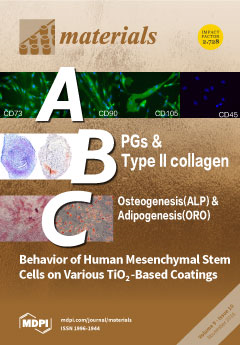Three kinds of N-doped mesoporous TiO
2 hollow spheres with different N-doping contents, surface area, and pore size distributions were prepared based on a sol–gel synthesis and combined with a calcination process. Melamine formaldehyde (MF) microspheres have been used as sacrificial template and
[...] Read more.
Three kinds of N-doped mesoporous TiO
2 hollow spheres with different N-doping contents, surface area, and pore size distributions were prepared based on a sol–gel synthesis and combined with a calcination process. Melamine formaldehyde (MF) microspheres have been used as sacrificial template and cetyltrimethyl ammonium bromide (CTAB) or polyvinylpyrrolidone (PVP) was selected as pore-directing agent. Core–shell intermediate spheres of titania-coated MF with diameters of 1.2–1.6 μm were fabricated by varying the volume concentration of TiO
2 precursor from 1 to 3 vol %. By calcining the core–shell composite spheres at 500 °C for 3 h in air, an in situ N-doping process occurred upon the decomposition of the MF template and CTAB or PVP pore-directing surfactant. N-doped mesoporous TiO
2 hollow spheres with sizes in the range of 0.4–1.2 μm and shell thickness from 40 to 110 nm were obtained. The composition and N-doping content, thermal stability, morphology, surface area and pore size distribution, wall thickness, photocatalytic activities, and optical properties of the mesoporous TiO
2 hollow spheres derived from different conditions were investigated and compared based on Fourier-transformation infrared (FTIR), SEM, TEM, thermogravimetric analysis (TGA), nitrogen adsorption–desorption, and UV–vis spectrophotoscopy techniques. The influences of particle size, N-doping, porous, and hollow characteristics of the TiO
2 hollow spheres on their photocatalytic activities and optical properties have been studied and discussed based on the composition analysis, structure characterization, and optical property investigation of these hollow spherical TiO
2 matrices.
Full article






